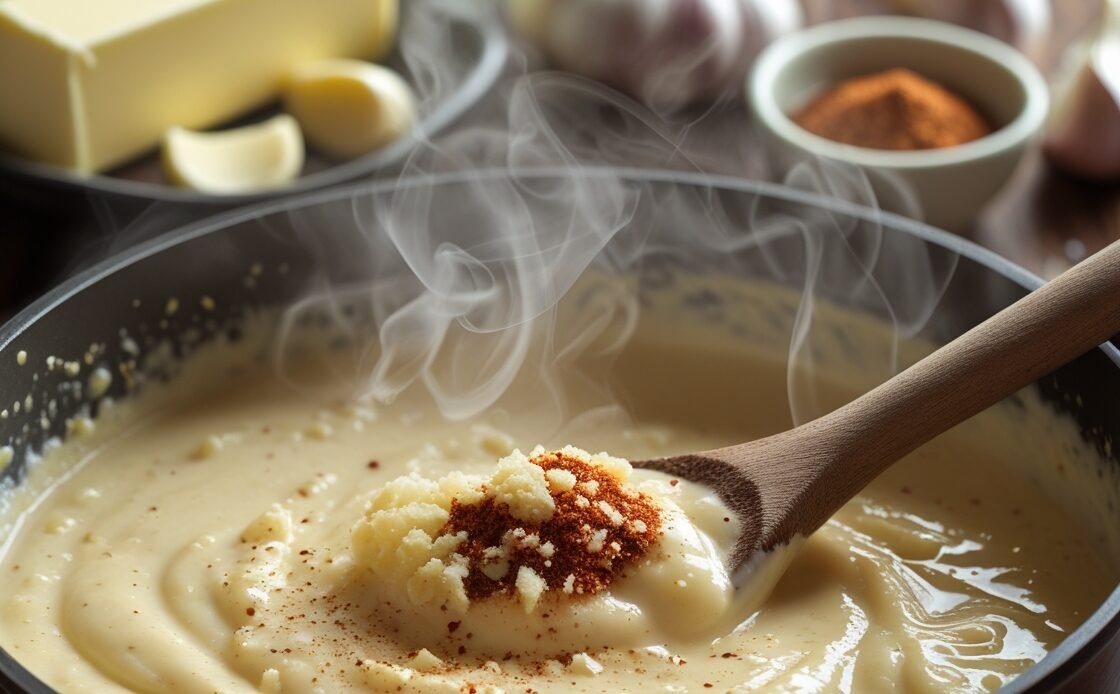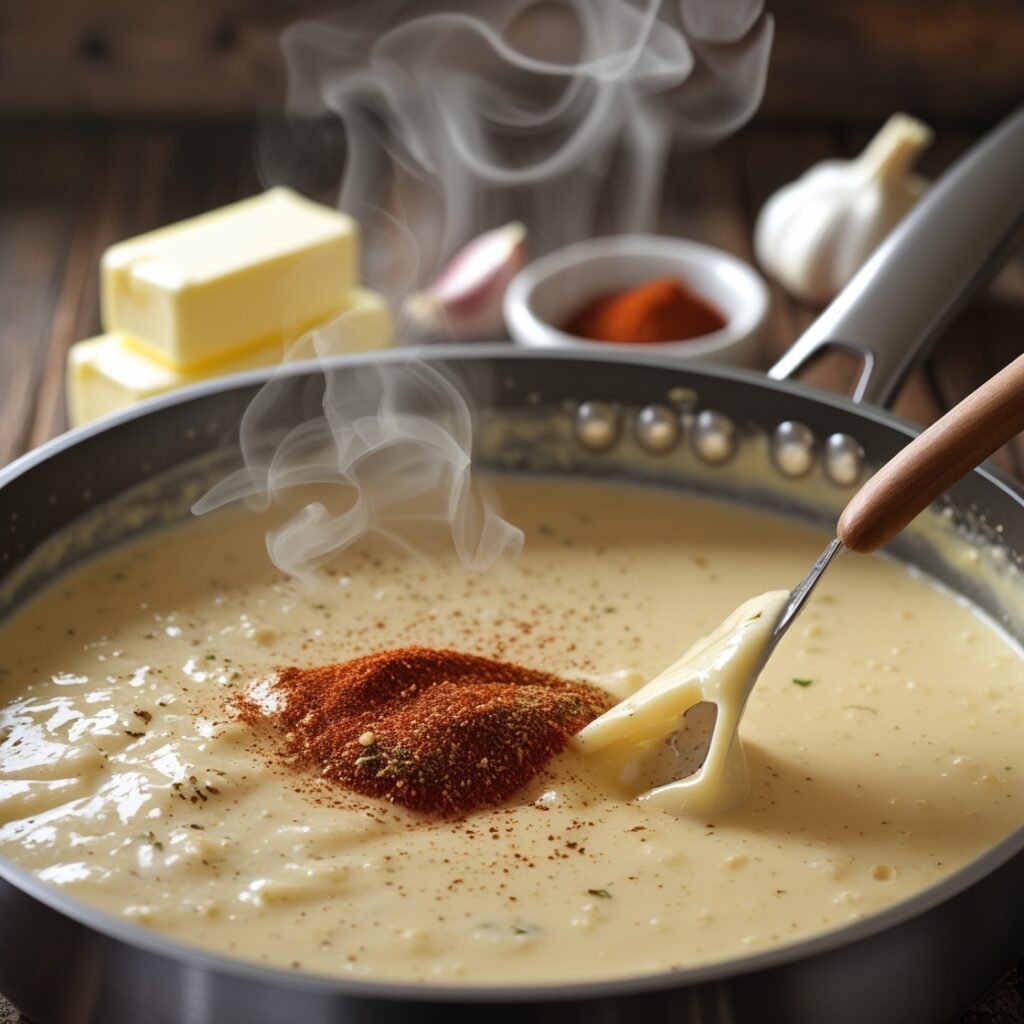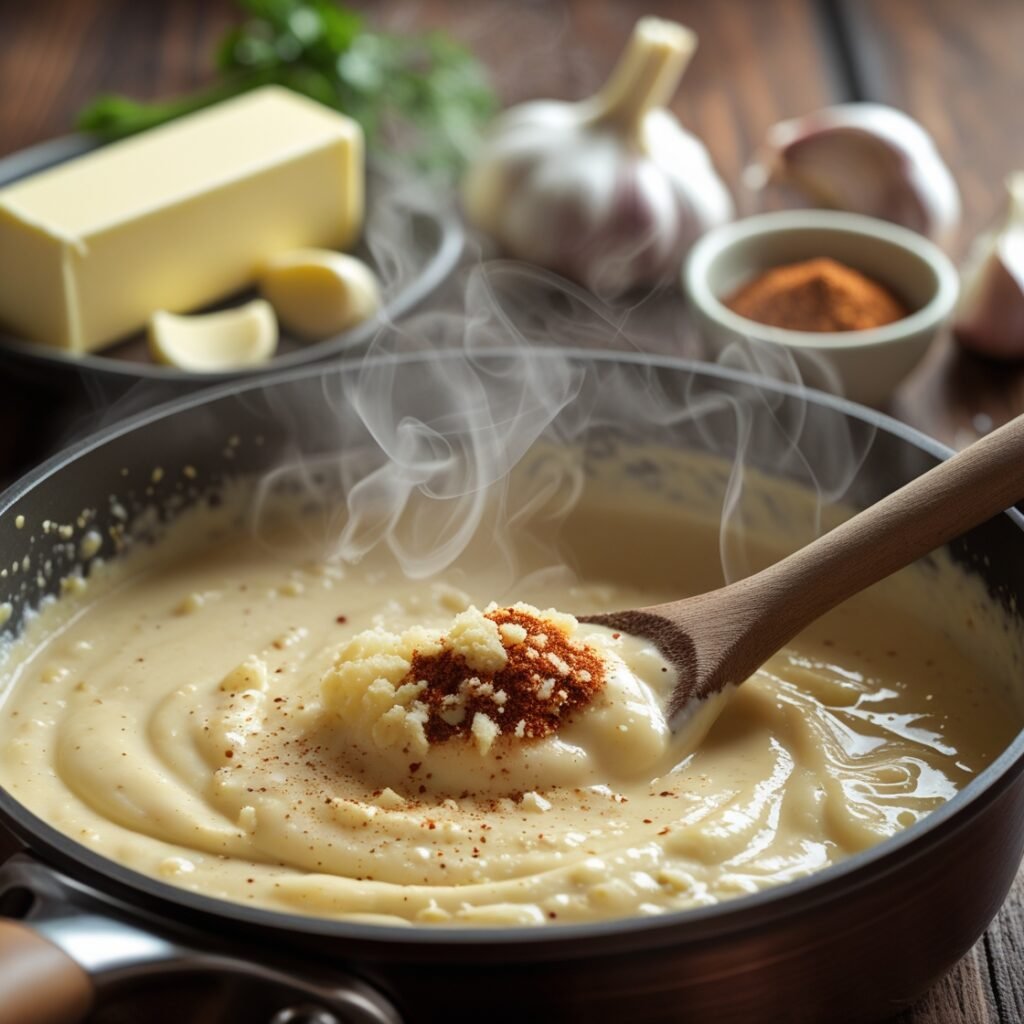
Ever wondered how cajun alfredo sauce combines the smooth richness of Italian cream sauce with the bold kick of Louisiana flavors? This guide shows you how to make a dish that brings together two culinary worlds. It’s irresistibly creamy and spice-forward, perfect for pasta, shrimp, or seafood boils.
Learn to balance umami cheese bases with cajun’s “holy trinity” of vegetables and spices. Every step, from making the roux to adjusting the seasoning, makes your cajun alfredo sauce a versatile pantry staple. Whether you love bold flavors or comfort food, this guide turns your kitchen into a place for bold, creamy flavor innovation.
Key Takeaways
- Mix Italian creaminess with cajun spices for a unique flavor fusion
- Master techniques to avoid common sauce mistakes like separation or overspicing
- Use everyday kitchen tools to create restaurant-quality cajun alfredo sauce
- Pair your sauce with proteins like shrimp, chicken, or even vegetables
- Customize heat levels to match your taste preferences

What Makes Cajun Alfredo Sauce Special
Cajun Alfredo sauce combines the creamy Alfredo sauce with the spicy Cajun flavors. This mix makes a dish that’s both cozy and bold. The creamy cajun pasta sauce has tangy garlic, smoky paprika, and a hint of cayenne. It’s made with butter and cheese, giving it a rich yet surprising taste.
The sauce’s magic lies in its balance. The cajun alfredo sauce adds spice carefully, so the heat doesn’t overwhelm the creaminess. A base of butter and cream provides a smooth start. Then, spices like cayenne and garlic add complexity. This balance makes each bite feel special, not overwhelming.
Texture is also key. The best sauces have a smooth feel with a bit of crunch from toasted garlic or crushed red pepper. The mix of smooth sauce and sharp spice adds depth. When done well, it turns simple pasta into a dish fit for a restaurant.
It’s also very versatile. You can use it as a base for shrimp, a pizza topping, or a dip. The creamy cajun pasta sauce works well with any protein or side. Learning to make this sauce means you have a secret ingredient that always impresses.
The Origins of Cajun Cuisine and Cream Sauces
Exploring cajun cream sauce and cajun alfredo sauce starts with Louisiana’s rich food history. This mix of cultures and tastes has made one of America’s most lively food traditions. Let’s dive into how it all started.
Louisiana Culinary Traditions
The Acadian settlers, now known as Cajuns, brought simple cooking to Louisiana in the 18th century. They used local foods like wild game, seafood, and smoked meats. These traditions grew into bold, spicy dishes, using the “Holy Trinity” of onion, celery, and bell pepper. Classics like gumbo and jambalaya paved the way for cajun cream sauce‘s creamy flavors.
The Italian-Cajun Fusion
“Cajun and Italian cuisines share a love for bold, layered flavors—perfect for blending.”
In the early 20th century, Italian immigrants came to New Orleans, bringing dishes like alfredo. Local chefs mixed cayenne, paprika, and smoked paprika into alfredo. This mix created cajun alfredo sauce, blending creamy richness with spicy notes. Places like Café Du Monde in New Orleans and chefs like Emeril Lagasse made these dishes famous.
Evolution of Cajun Cream Sauces in American Cooking
Now, cajun cream sauce is a key part of American fusion cooking. Here’s a look at its main influences:
| Element | Cajun Influence | Italian Influence |
|---|---|---|
| Base | Smoked meats, local herbs | Heavy cream, Parmesan |
| Signature Flavors | Paprika, cayenne, and andouille sausage | Creamy texture, garlic, butter |
| Modern Use | Seafood boils, etouffée | Pasta dishes, shrimp recipes |
By the 1980s, chefs like Paul Prudhomme made cajun alfredo sauce a hit nationwide. Today, it’s used in everything from pasta to fried chicken, showing its lasting appeal.
Essential Ingredients for Authentic Cajun Alfredo Sauce
Mastering cajun cream sauce begins with the right ingredients. Each one is crucial for the perfect mix of creaminess and flavor. Here’s what you’ll need to start.
The Base: Butter, Cream, and Cheese
Begin with unsalted butter for easy seasoning. Use heavy cream (35% fat) for a smooth texture. Add sharp cheddar or a mix of Parmesan and Pecorino Romano for richness. For a lighter creamy cajun pasta sauce, mix in some whole milk.
The Cajun Holy Trinity
Dice onions, celery, and bell peppers finely for even cooking. Sauté them until they’re soft. This creates the sauce’s aromatic base. These three are key to authentic Cajun taste.
Spices That Define Cajun Flavor
| Spice | Flavor Contribution | Usage Tip |
|---|---|---|
| Paprika | Smoky, earthy warmth | Add 1 tsp first to toast with butter |
| Cayenne | Heat level adjustable to taste | Start with ½ tsp and adjust |
| Garlic Powder | Umami depth | Use 1 tsp to avoid raw garlic notes |
| Thyme | Herbaceous undertones | 1 tsp fresh or ½ tsp dried |
Optional Add-ins for Enhanced Flavor
- Minced garlic or shallots for extra depth
- Chopped parsley or green onions for freshness
- Worcestershire sauce for umami boost
- White wine to deglaze the pan
Using quality ingredients makes every bite of your cajun cream sauce a true mix of Italian and Cajun flavors.
Kitchen Tools You’ll Need
Before you start making cajun alfredo sauce, get the right tools. The right tools help avoid mistakes and make your dish better. Here’s what you’ll need:
- Heavy-Bottomed Pan: A 3- to 4-quart saucepan or skillet made of stainless steel, enameled cast iron, or cast iron. These materials distribute heat evenly to prevent scorching.
- Whisk: A wire whisk blends cream and cheese seamlessly. A silicone-tipped whisk prevents scratching nonstick pans.
- Sharp Knife and Cutting Board: For chopping the Cajun holy trinity (onion, celery, bell pepper) into uniform pieces.
- Measuring Cups/Spoons: Precision matters for balancing flavors in cajun alfredo sauce.
- Spatula: A silicone or heatproof spatula stirs without scratching pans.
| Purpose | Recommended Tools | Why It Matters |
|---|---|---|
| Heat Control | Heavy-bottomed pan | Prevents burning dairy in cajun alfredo sauce. |
| Texture | Whisk | Ensures smooth sauce without lumps. |
| Prep | Sharp knife | Efficient vegetable chopping for even cooking. |
Optional upgrades include a microplane grater for finely shredding Parmesan or garlic, or an immersion blender for ultra-smooth sauces. If you lack cast iron, use a nonstick skillet—just reduce heat slightly to avoid burning. Proper tools make the difference between a lumpy mess and a creamy, flavorful cajun alfredo sauce.
Preparing Your Ingredients for Cajun Alfredo Sauce
Getting your ingredients ready right is key to a great cajun cream sauce for shrimp or creamy cajun pasta sauce. It saves time and boosts flavor. Here’s how to get your kitchen and ingredients ready before you start cooking.
Proper Vegetable Preparation Techniques
Begin by cutting the Cajun Holy Trinity—onion, celery, and bell pepper—into ¼-inch pieces. This ensures they cook evenly. Use a sharp knife or mandoline for precise cuts. For creamy cajun pasta sauce, finely chop garlic and ginger to blend well with the sauce.
Measuring and Organizing Spices
Follow the French mise en place method: measure spices like paprika, cayenne, and thyme into small bowls. Mix a Cajun blend with paprika, garlic powder, onion powder, and a bit of cayenne. Store it in an airtight jar for later use. Use equal parts salt and spice for the right heat.
Protein Preparation for Complementary Additions
Prep varies by protein type. For shrimp, rinse, remove veins, and pat dry. Season with lemon and Cajun blend before cooking. Chicken? Trim fat, cut into cubes, and marinate in buttermilk for 30 minutes. Here’s a table for specific protein prep:
| Protein | Prep Steps |
|---|---|
| Shrimp | Devein, season with Cajun blend, marinate 10 mins |
| Chicken | Cut into 1-inch cubes, remove connective tissue |
| Seafood | Pat dry, dust with flour for even coating |
Organize your prepped ingredients in clear containers labeled “vegetables,” “spices,” and “protein.” This makes cooking smoother and ensures everything blends well in your dish.
Step-by-Step Cooking Process
“The best cajun alfredo sauce starts with precision and patience.” — Chef Marie Laveau, New Orleans culinary instructor

Creating the Perfect Roux
Start by mixing equal parts butter and flour in a saucepan over medium heat. Whisk constantly until it turns blonde (3-5 minutes) for a light flavor or peanut butter (8-10 minutes) for a richer taste. If it starts to burn, lower the heat.
Incorporating Cream Without Curdling
- Slowly pour cold cream into the roux while whisking hard.
- Keep the heat low to avoid boiling.
- Add small amounts of cream first to temper the mixture.
Achieving Ideal Consistency
| Issue | Solution |
|---|---|
| Too Thin | Add 1 tbsp flour mixed with water |
| Too Thick | Thin with warm broth or milk |
| Grainy Texture | Strain sauce through a fine-mesh sieve |
Balancing Heat and Flavor
Season with cayenne and paprika early to blend flavors. Taste often and adjust with:
- More cream for creaminess
- Hot sauce for heat
- Grated Parmesan for salt balance
Simmer the cajun cream sauce uncovered to reduce moisture. This way, it sticks to pasta without pooling.
Delicious Variations of Creamy Cajun Pasta Sauce
Make your cajun cream sauce even better with these simple changes. Try different flavors to suit your taste, dietary needs, or any special event:
- Seafood-Infused Cajun Alfredo – Mix clam juice or fish stock with the cream. Add shrimp, crab, or scallops for a unique taste. It’s great with linguine or as a dip.
- Smoky Cajun Cream Sauce – Cook onions in bacon fat first. Then, add smoked paprika and a bit of liquid smoke. It’s perfect over pulled pork or baked potatoes.
- Vegetable-Forward Option – Blend sautéed mushrooms, roasted bell peppers, or butternut squash into the sauce. Serve with zucchini noodles or whole-wheat pasta for a filling meal.
- Lightened-Up Version – Use half cream and half milk or broth. Choose part-skim cheese. Add olive oil on top for extra flavor without too much fat.
- Fire-Roasted Cajun – Increase cayenne and crushed red pepper. Add hot sauce for more heat. Cool it down with lemon or sour cream.
Enjoy your sauce with grilled meats, steamed veggies, or baked fries. Start with small spice additions to avoid too much flavor. For a big event, make double the sauce and serve with bread for dipping. Your creamy cajun pasta sauce is now a canvas for your culinary dreams, whether you’re in the mood for comfort or something new.
Serving Your Cajun Cream Sauce for Shrimp and Other Dishes
Once you’ve made your Cajun cream sauce, learn how to serve it. It’s all about highlighting its bold flavors. You can pair it in classic ways or try something new. These tips will make every bite a delight.
Perfect Pasta Pairings
Choose pasta shapes that hold onto the sauce well. Fettuccine and linguine are great because they stick to the sauce. For something heartier, penne is a good choice because it catches herbs and spices.
Always cook pasta until it’s al dente. This prevents it from becoming mushy. Also, save some pasta water to adjust the sauce’s thickness if needed.
Cajun Cream Sauce for Fish and Seafood
Seafood makes the sauce even better. For cajun cream sauce for shrimp, toss cooked shrimp in the sauce for 2–3 minutes. This prevents them from becoming tough. Add a squeeze of lemon for a burst of freshness.
“Pair with rice pilaf for a coastal Louisiana twist,”
seafood chefs recommend. For cream sauce for fish, use firm whitefish like cod or tilapia. Pan-fry the fish first, then coat it in the sauce for 5 minutes. Try it with blackened catfish or grilled scallops.
Unexpected Dishes Enhanced by Cajun Alfredo
Don’t just stick to pasta. Use the sauce on baked chicken breasts or drizzle it over loaded baked potatoes with bacon and chives. For a party favorite, spread it on pizza dough with crawfish and spinach before baking.
Use it as a dipping sauce for fried pickles or zucchini fries. This adds a delicious twist to your dishes.
| Seafood Option | Best Cooking Method |
|---|---|
| Shrimp | Sauté briefly (2-3 mins) in sauce |
| Scallops | Sear first, then simmer in sauce |
| Catfish | Pan-fry and finish in sauce |
Pair your dishes with crusty bread to enjoy the leftover sauce. Add parsley or green onions for a fresh touch. Adjust the spice to your liking before serving.
Storage Tips and Reheating Your Sauce
Keeping your cajun alfredo sauce fresh is key. Cool it down to room temperature first. Then, put it in an airtight container. Don’t leave it out for more than two hours to avoid bacteria.
Store it in the fridge for up to four days. Use glass or BPA-free containers. This keeps flavors pure and prevents skin from forming.
- Refrigerate within two hours of cooking.
- Stir before storing to blend ingredients evenly.
- Use containers with tight seals to avoid odor absorption.
Freezing cajun cream sauce is possible but needs care. Pour cooled sauce into heavy-duty freezer bags, pressing out air. Lay flat to freeze, as upright containers risk bursting. Thaw in the fridge overnight before reheating, as freezing may cause slight texture changes.
Reheat your sauce gently to avoid curdling. Use one of these methods:
- Stovetop: Simmer on low heat, stirring constantly with a wooden spoon.
- Microwave: Heat in 30-second bursts, stirring after each interval.
- Water Bath: Place sauce in a heat-safe bowl over a pot of simmering water. Stir until hot.
“If your cajun alfredo sauce separates, whisk in a tablespoon of cream while reheating,” says Chef Marie Laveau of New Orleans Culinary Institute. “Adding a dash of cornstarch mixed with water can also restore texture.”
Discard sauce after four days in the fridge or if it develops off odors or mold. Prioritize fresh batches for the best flavor and safety. Always check internal temperature reaches 165°F when reheating to ensure safety.
Troubleshooting Common Sauce Issues
Even the best chefs face setbacks when making cajun alfredo sauce. Don’t panic if your sauce separates, thickens too much, or loses flavor. These fixes work for any creamy cajun pasta sauce mishap:
Fixing a Broken or Separated Sauce
Separted sauces happen when fat and liquid layers form. Try these steps:
- Slowly drizzle warm cream into the sauce while whisking vigorously.
- Make a new roux (butter + flour) and blend it gradually into the broken sauce.
- For severe separation, use an immersion blender to emulsify the mixture.
Adjusting Thickness and Consistency
Too thin? Too thick? Here’s how to fix it:
| Problem | Solution |
|---|---|
| Too thin | Reduce heat, simmer uncovered to evaporate excess liquid |
| Too thick | Whisk in small amounts of warm broth or cream |
Balancing Flavors When Something’s Off
- Too salty: Add a diced raw potato to absorb salt, then strain. Stir in unsalted dairy.
- Not spicy enough: Mix in cayenne or hot sauce gradually. Add more smoked paprika for depth.
- Overly hot: Fold in a splash of heavy cream or a dollop of sour cream to mellow heat.
Nutritional Considerations and Lighter Alternatives
Cajun cream sauce and cream sauce for fish can be enjoyed in a healthier way. Traditional recipes are high in calories and fat. But, you can make them healthier without losing flavor.
Choose whole-grain pasta or eat smaller portions. Add veggies like broccoli or asparagus to increase fiber and vitamins.
“A ½-cup serving of classic cajun cream sauce has about 350 calories, but swaps like 2% milk mixed with yogurt can cut calories by 20%,” says registered dietitian Emily Carter.
- Use low-fat Greek yogurt or evaporated skim milk to lighten cream sauce recipes.
- For cream sauce for fish, try coconut milk (unsweetened) for a dairy-free option that complements seafood.
- Replace part of the roux with cornstarch for gluten-free thickening.
| Aspect | Traditional | Lighter Option |
|---|---|---|
| Calories per ½ cup | 350 | 250–280 |
| Fat content | 28g | 18–20g |
| Protein | 6g | 9–11g (with added Parmesan or white beans) |
Try smoked paprika or garlic powder to add depth without salt. Keto fans can enjoy full-fat versions in small amounts. Pair with zucchini noodles. Always taste and adjust spices after making changes to keep that cajun cream sauce flavor.
Conclusion
Making Cajun Alfredo sauce at home turns simple meals into bold, tasty dishes. It combines Louisiana’s spicy flavors with creamy Italian touches. This mix creates a recipe that’s both cultural and delicious.
By mastering a roux and balancing spices, you can avoid common mistakes. This ensures your sauce tastes like it’s from a restaurant every time.
This sauce is great over pasta, with shrimp, or as a sauce for fish. You can also add your favorite ingredients to make it even better. Just remember to store it right and adjust the consistency as needed.
Now, it’s time to get cooking. Try the recipe and adjust the spices to your taste. Share your creations with others who love to cook. The skills you’ve learned can be used for many dishes.
Whether you’re making Cajun Alfredo with salmon or pasta and crawfish, your kitchen is where magic happens. Enjoy the journey, keep improving, and watch your cooking skills grow. Bon appétit!
FAQ
What is Cajun Alfredo sauce?
Cajun Alfredo sauce is a creamy sauce. It mixes Italian alfredo with Cajun spices. This mix gives a rich taste that makes pasta dishes better.
How can I make a creamy Cajun pasta sauce from scratch?
Start with a roux of butter and flour. Then, add cream slowly. Mix in Parmesan cheese for thickness and Cajun spices for flavor. Adjust the taste and add proteins or veggies as you like.
What are some tips for preparing Cajun cream sauce for shrimp?
Clean and devein your shrimp first. Cook them in the sauce until they’re just done. This helps them soak up the flavors. Adjust the spice level to your taste and avoid overcooking.
Can I use Cajun Alfredo sauce for fish dishes?
Yes! It’s great with fish like catfish and whitefish. Pan-sear or bake the fish lightly. Then, drizzle the sauce over it for a tasty mix.
What are common substitutes for heavy cream in Cajun cream sauce?
You can use half-and-half, evaporated milk, or cashew cream for a dairy-free option. Each will change the sauce’s richness and texture. Adjust the other ingredients accordingly.
How can I store and reheat Cajun Alfredo sauce?
Cool the sauce quickly and put it in an airtight container. It lasts 3-4 days in the fridge. Reheat it gently on the stovetop or in the microwave, stirring often.
What are some delicious variations of creamy Cajun pasta sauce?
Try seafood versions with fish stock for depth. Or, make a smokier version with bacon. You can also use roasted red peppers or Greek yogurt for lighter options.
What spices are essential for a flavorful Cajun Alfredo sauce?
Use paprika, cayenne pepper, garlic powder, black pepper, and thyme. These spices create the bold flavor of Cajun cuisine. Adjust the amounts to your taste.
Can I use this cream sauce in unexpected dishes?
Yes! Cajun Alfredo sauce is versatile. It’s great on baked potatoes, pizzas, or grilled chicken. Its creamy texture and rich flavor can make simple meals special.




